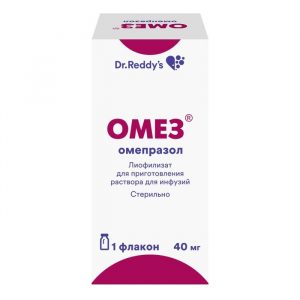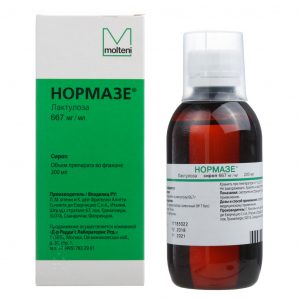Description
Latin name
Motilium
Packing
Bottle 100 ml.
Pharmacological action
MOTILIUM – an antiemetic, a central blocker of dopamine receptors. Domperidone is a dopamine antagonist with antiemetic properties.
Domperidone penetrates poorly through the BBB. The use of domperidone is very rarely accompanied by extrapyramidal side effects, especially in adults, but domperidone stimulates the release of prolactin from the pituitary gland. Antiemetic effect possibly due to a combination of peripheral (gastrokinetic) action and antagonism to dopamine receptors in the chemoreceptor trigger zone,
located outside the BBB in the area postrema. Animal studies, as well as low drug concentrations found in the brain, indicate a predominantly peripheral effect of domperidone on dopamine receptors.
When used internally in humans, domperidone increases the pressure of the lower esophageal sphincter, improves antroduodenal motility and accelerates gastric emptying.
Domperidone has no effect on gastric secretion.
Pharmacokinetics
Absorption
After oral administration, fasting, domperidone is rapidly absorbed from the digestive tract. Cmax in blood plasma is reached within about 30-60 minutes. The low absolute bioavailability of domperidone when administered orally (approximately 15%) is due to extensive primary metabolism in the intestinal wall and liver.
Although in healthy people the bioavailability of domperidone is increased when taken after meals, patients with gastrointestinal complaints should take domperidone 15-30 minutes before meals. Reducing the acidity of gastric juice leads to a decrease in the absorption of domperidone. Oral bioavailability decreases with prior administration of cimetidine and sodium bicarbonate. When taking the drug after meals, it takes longer to achieve maximum absorption, and the AUC increases slightly.
Distribution of
When ingested, domperidone does not accumulate and does not induce its own metabolism. Cmax in plasma of 21 ng / ml after 90 minutes after 2 weeks of ingestion at a dose of 30 mg / day was almost the same as Cmax in plasma of 18 ng / ml after taking the first dose.
The binding of domperidone to plasma proteins is 91-93%.
Animal distribution studies using a drug labeled with a radioactive isotope showed a significant distribution of the drug in tissues, but low concentrations in the brain. Small amounts of the drug cross the placental barrier in rats.
Metabolism
Domperidone undergoes rapid and extensive metabolism in the liver by hydroxylation and N-dealkylation. In vitro metabolism studies using diagnostic inhibitors have shown that CYP3A4 is the main isoenzyme of the P450 cytochrome system. involved in the process of N-dealkylation of domperidone, while the isoenzymes CYP3A4, CYP1A2 and CYP2E1 are involved in the process of aromatic hydroxylation of domperidone.
Excretion
Excretion with urine and feces is 31% and 66% of the dose when taken orally, respectively.
The proportion of the drug excreted unchanged is small (10% with feces and approximately 1% with urine).
T1 / 2 from blood plasma after a single oral administration in healthy volunteers is 7-9 hours.
Pharmacokinetics in special clinical cases
In patients with severe renal insufficiency, severe T1 / 2 domperidone increases. In such patients (serum creatinine> 6 mg / dl, i.e.> 0.6 mmol / l), T1 / 2 of domperidone increases from 7.4 hours to 20.8 hours, but the concentration of the drug in the blood plasma is lower, than people with normal kidney function. A small amount of unchanged drug (about 1%) is excreted by the kidneys.
In patients with moderate liver dysfunction (Pew score of 7 9, Class B on the Child-Pugh scale), AUC and Cmax of domperidone are 2.9 and 1.5 times higher than in healthy people, respectively. The unbound fraction increases by 25%, and the final T1 / 2 increases from 15 hours to 23 hours. In patients with mild hepatic impairment, the systemic effect is slightly reduced compared to that in healthy people based on Cmax and AUC values without changing protein binding or final T1 / 2. For patients with severely impaired liver function, data are not available.
No pharmacokinetic data available for children.
Indications
A complex of dyspeptic symptoms, often associated with delayed gastric emptying, gastroesophageal reflux, esophagitis:
feeling of fullness in the epigastrium, early satiety, feeling of bloating, pain in the upper abdomen
belching, flatulence
nausea, vomiting
heartburn, burping it with gastric contents.
Nausea and vomiting of functional, organic, infectious origin, as well as caused by drug therapy or a violation of diet.
A specific indication is nausea and vomiting caused by dopamine agonists if used for Parkinson’s disease (such as levodopa and bromocriptine).
Contraindications
prolactin-secreting pituitary tumor (prolactinoma)
concomitant use of oral forms of ketoconazole, erythromycin or other potent inhibitors of the CYP3A4 isoenzyme, such as amloronolone, foloronololone gastric function can be dangerous, for example, with gastrointestinal bleeding, obstruction or perforation
impaired liver function is moderate or severe degree
hypersensitivity to domperidone or any of the components.
Precautions: impaired renal function, impaired rhythm and conduction of the heart, including prolongation of the QT interval, electrolyte imbalance, congestive heart failure.
Use during pregnancy and lactation
Data on the use of Motilium during pregnancy are insufficient.
To date, there is no evidence of an increased risk of malformations in humans. However, the use of Motilium during pregnancy (especially in the first trimester) is possible only in cases when the expected benefits of therapy to the mother outweigh the potential risk to the fetus.
In women, the concentration of domperidone in breast milk is 10-50% of the corresponding plasma concentration and does not exceed 10 ng / ml. The total amount of domperidone excreted in breast milk is less than 7 mcg / day when using the maximum permissible doses. It is not known whether this level has a negative effect on newborns.
Therefore, if it is necessary to use Motilium during lactation, it is recommended to stop breastfeeding, unless the expected benefit outweighs the potential risk.
Composition srdlp suspension 1 ml: srdlp substance:
domperidone 1 mg
Excipients:
sodium saccharin,
microcrystalline cellulose,
sodium carboxymethyl cellulose,
sorbitol,
methyl parahydroxybenzoate,
ropypropyl
sodium hydroxide,
polysorbate,
purified water.
Dosage and administration of
It is recommended to take the drug Motilium before meals, if taken after meals, the absorption of domperidone slightly slows down.
The duration of continuous use of the drug without the recommendation of a doctor should not exceed 28 days.
Adults and adolescents over 12 years of age and weighing 35 kg or more: 10-20 ml 3-4 times a day. The maximum daily dose is 80 ml (80 mg).
Infants and children up to 12 years of age: 0.25-0.5 mg domperidone (0.25-0.5 ml suspension) per 1 kg of body weight 3-4 times a day. The maximum daily dose is 2.4 mg / kg, but not more than 80 ml (80 mg). To determine the dose, use a child’s body mass scale of 0-20 kg on a syringe.
Patients with impaired renal function: since T1 / 2 of domperidone increases with severe impaired renal function, with repeated use, the frequency of taking Motilium should be reduced to 1-2 times / day, depending on the severity of the impairment, a dose reduction may also be required. With prolonged therapy, regular examination of such patients should be carried out.
Patients with impaired liver function: Motilium is contraindicated in moderate to severe hepatic impairment. For mild hepatic impairment, dose adjustment is not required.
Rules for the use of
suspension Before use, mix the contents of the vial, shaking it gently to avoid foam formation.
Suspension is packaged to protect against accidental opening by children. The bottle should be opened as follows: press down on the plastic cap of the bottle, while turning it counterclockwise to remove the unscrewed cap.
Place syringe in vial. Holding the lower ring in place, raise the upper one to the mark corresponding to the child s body weight (kg). Holding the lower ring, remove the filled syringe from the vial. Empty the syringe. Close the bottle. Rinse the syringe with water.
Drug Interaction
Anticholinergic drugs can counteract the antidispersive action of Motilium.
The bioavailability of Motilium when taken orally is decreased after prior administration of cimetidine or sodium bicarbonate. Antacid and antisecretory drugs should not be taken at the same time as Motilium, since they reduce its bioavailability.
The major pathway of metabolic conversion of domperidone occurs with the participation of the cytochrome P450 isoenzyme 3A4. Based on in vitro studies, it can be suggested that, with the simultaneous use of domperidone and drugs that significantly inhibit this isoenzyme, plasma levels of domperidone may be increased.
Examples of CYP3A4 isoenzyme inhibitors include the following drugs: antifungal drugs azole series, macrolide antibiotics, HIV protease inhibitors, nefazodone.
In a study of healthy volunteers, the interaction of domperidone with ketoconazole revealed that ketoconazole inhibited CYP3A4-dependent primary metabolism of domperidone, resulting in an approximately threefold increase in domperidone Cmax and AUC in the plateau phase. In the study of the interaction of domperidone and ketoconazole, it is shown that when co-administered with domperidone at a dose of 10 mg 4 times / day and ketoconazole at a dose of 200 mg 2 times / day, there is an increase in the QT interval by 10-20 ms. No clinically relevant changes in the QT interval were observed with single-dose domperidone at similar doses or at a daily dose of 160 mg (2 times the maximum permissible daily dose).
Theoretically (since the drug has a gastrokinetic effect) Motilium could affect the absorption of concurrently used drugs, in particular, drugs with delayed release of the active substance, or drugs coated with the enteric shell. However, the use of domperidone in patients on the background of taking acetaminophen or matched digoxin therapy did not affect the level of these drugs in the blood.
Motilium can also be combined with neuroleptics, the action of which it does not potentiate dopaminergic receptor agonists (bromocriptine, levodopa), the undesirable peripheral effects of which, such as digestive disorders, nausea, vomiting, it suppresses, not neutralizing them.
Overdose
Symptoms: drowsiness, disorientation and extrapyramidal reactions, especially in children.
Treatment: There is no specific antidote for domperidone. In case of overdose, gastric lavage and activated charcoal are recommended. It is recommended that the patient be closely monitored and supportive therapy performed. Anticholinergics, drugs used for the treatment of parkinsonism, or antihistamines may be effective in extrapyramidal reactions.
Storage conditions
The drug should be stored out of the reach of children at a temperature of 15 ° to 30 ° C.
Expiration
5 years.
Active ingredient
Domperidone
dosage form
dosage form
oral suspension
Janssen Pharmaceutical N.V., Belgium




